< Naples, Pompeii and Capri
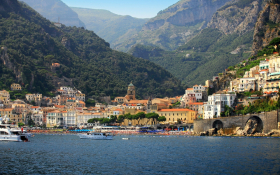
Naples is not far from Rome. It can be reached easily by train or by car and once there you can go and explore also Pompeii or the Amalfi Coast or take a boat and go to Capri Island, the pearl of the Mediterranean sea, situated in an emerald and turquoise sea;
Naples, Pompeii and Capri

Naples is not far from Rome. It can be reached easily by train or by car and once there you can go and explore also Pompeii or the Amalfi Coast or take a boat and go to Capri Island, the pearl of the Mediterranean sea, situated in an emerald and turquoise sea;
< Trevi Fountain
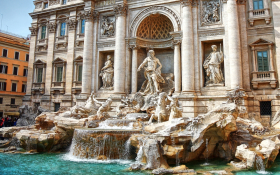
Visit the beautiful fountain Fontana di Trevi. A most beautiful fountain it is said that if you throw a coin into it over you shoulder then you shall return to the city over and over again. Neptune supported by Tritons on either side statutes are in the center of the fountain.
< The Vatican City
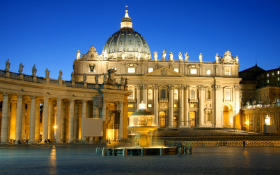
This tiny, independent city was founded in AD 90, when the first monument was built on what was believed to be the site of St Peter’s martyrdom. In the fourth century the emperor Constantine built a basilica over the tomb. And then, after a series of invasions, Pope Leo IV encircled the area with an imposing 12-metre wall, which expanded over the centuries to surround more land. Confined behind the wall after the Italian Unification of 1870, and acting as an independent state since 1929, the Vatican leads a separate existence from the rest of Rome. Because of that, its main sights can, and do, observe a strict dress code, you will not be allowed in if you wear clothing that bares your legs or shoulders. Credit cards aren’t accepted, though the Vatican is a duty-free zone. Once inside, the first stop has to be St Peter’s Basilica. The dome, when completed in 1590 to Michelangelo’s detailed specifications, was the largest brick construction ever built. Visitors ascend via a cramped lift and then many stairs. At the top there are fabulous views of the Vatican Gardens, Bernini’s piazza and the city beyond. Below the dome, Bernini’s curlicued bronze canopy triumphs over the altar. Under the chapels, one containing Michelangelo’s Pieta, are the tombs of recent popes, including John Paul II. Further down, the Necropolis is where many believe St Peter is buried. The Vatican Museums are so huge that there are four colour-coded itineraries to choose from. The basilica end of the route has the Sistine Chapel, containing Michelangelo’s frescoes of the Creation and the Last Judgement, and luscious Renaissance works by Botticelli, Rosselli and Signorelli.
< Ancient Ostia
The ruins of the port of ancient Rome reveal more than any other monument in the capital, what everyday life must have been like in ancient times. Situated amongst cypresses and Mediterranean pine trees.
< Piazza di Spagna
A theatrical square used for international meetings. It has a set of Spanish steps leading up to the entrance. One of the world’s most important fashion shows is held here. The square leads into the famous streets of the city of Rome and the exquisite boutiques and shops.
< Roman Castles
Small medieval villages outside Rome. An opportunity to leave the capital and immerse yourself in the natural and artistic beauty of the Roman countryside.
< Roman Forum
The Roman Forum was the center of the economic, political and social life of the city. It includes the remains of the triumphal arch of Emperor Septimius Severus. Shakespeare's play after Julius Caesar's assassination, Mark Anthony spoke in this forum. Admission is free and there are tours of the area.
< Rome - Overview
The one thing you cannot escape from in Rome is history. This exciting metropolis oozes with it. But neither will you escape the hectic vibrancy of the place, with its anarchic traffic, its noise, its piazzas, its fountains, its fabulous restaurants and all the other idiosyncrasies that make Rome quite simply one of the most remarkable cities in the world. Whether it's Etruscan tombs, Republican meeting rooms, early-Christian churches, Renaissance palaces, baroque basilicas, the Vatican or the great swathe of artefacts left by the Roman Empire, the sense of history that Rome provides is all embracing. It's a bustling city in which a great deal of life takes place outdoors; people mix, for instance, in the piazzas around parliament, where you might see politicians and journalists chatting with the man sweeping the streets, or pacing up and down outside the bar in Via Uffici del Vicario, avidly talking into their mobile phones. Whether it's history, or humanity, Rome is quite simply a feast for the eyes. Away from the Classical sights, districts like Trastevere and the former Jewish Ghetto reveals a different side to Rome, of narrow medieval cobbled streets, authentic Roman trattories, cafes and neighbourhood atmosphere. The glorious parkland around Villa Borghese offers a quiet retreat from the city; whilst popular excursions from Rome, such as Via Appia to the catacombs, Ostia Antica and Tivoli, are all within easy reach.
< The Colosseum
Over 160 ft high with eighty entrances, the Coliseum could hold upwards of 50,000 spectators. Public events such as gladiator fights, mock naval battles and wild animal hunts were held at the Coliseum. During the staged fights as many as 10,000 people were killed. Fighters were slaves, prisoners or volunteers. Spectators saw persecuted Christians killed by lions. After 404 AD gladiatorial battles were no longer held, but animals such as lions, elephants, snakes and panthers continue to be massacred in the name of sport until the 6th century.
< The Pantheon
The Pantheon is a beautiful spiritual structure and a must see. Commissioned by Marcus Agrippa it was rebuilt by Hadrian, who wanted to add a dome to it. It was then turned into a church early 7th century by Pope Boniface IV. The only source of light in the building is from the dome.
< Tivoli
This excursion allows you to visit and compare two splendid villas from two different ages. The Villa Adriana dating back to Roman times and the Villa D'Este from the Renaissance period. Along the ancient Via Tiburtina, 30 km east of Rome.
< Trastevere
Originally built to be like a warehouse to store goods in it was then later changed into very desirable residential quarter. There are still some well-preserved medieval houses and on some of the walls of the buildings you an see the grafitti the soldier wrote while they were on guard for the emperor.
Trevi Fountain

Visit the beautiful fountain Fontana di Trevi. A most beautiful fountain it is said that if you throw a coin into it over you shoulder then you shall return to the city over and over again. Neptune supported by Tritons on either side statutes are in the center of the fountain.
The Vatican City

This tiny, independent city was founded in AD 90, when the first monument was built on what was believed to be the site of St Peter’s martyrdom. In the fourth century the emperor Constantine built a basilica over the tomb. And then, after a series of invasions, Pope Leo IV encircled the area with an imposing 12-metre wall, which expanded over the centuries to surround more land. Confined behind the wall after the Italian Unification of 1870, and acting as an independent state since 1929, the Vatican leads a separate existence from the rest of Rome. Because of that, its main sights can, and do, observe a strict dress code, you will not be allowed in if you wear clothing that bares your legs or shoulders. Credit cards aren’t accepted, though the Vatican is a duty-free zone. Once inside, the first stop has to be St Peter’s Basilica. The dome, when completed in 1590 to Michelangelo’s detailed specifications, was the largest brick construction ever built. Visitors ascend via a cramped lift and then many stairs. At the top there are fabulous views of the Vatican Gardens, Bernini’s piazza and the city beyond. Below the dome, Bernini’s curlicued bronze canopy triumphs over the altar. Under the chapels, one containing Michelangelo’s Pieta, are the tombs of recent popes, including John Paul II. Further down, the Necropolis is where many believe St Peter is buried. The Vatican Museums are so huge that there are four colour-coded itineraries to choose from. The basilica end of the route has the Sistine Chapel, containing Michelangelo’s frescoes of the Creation and the Last Judgement, and luscious Renaissance works by Botticelli, Rosselli and Signorelli.
Ancient Ostia
The ruins of the port of ancient Rome reveal more than any other monument in the capital, what everyday life must have been like in ancient times. Situated amongst cypresses and Mediterranean pine trees.
Piazza di Spagna
A theatrical square used for international meetings. It has a set of Spanish steps leading up to the entrance. One of the world’s most important fashion shows is held here. The square leads into the famous streets of the city of Rome and the exquisite boutiques and shops.
Roman Castles
Small medieval villages outside Rome. An opportunity to leave the capital and immerse yourself in the natural and artistic beauty of the Roman countryside.
Roman Forum
The Roman Forum was the center of the economic, political and social life of the city. It includes the remains of the triumphal arch of Emperor Septimius Severus. Shakespeare's play after Julius Caesar's assassination, Mark Anthony spoke in this forum. Admission is free and there are tours of the area.
Rome - Overview
The one thing you cannot escape from in Rome is history. This exciting metropolis oozes with it. But neither will you escape the hectic vibrancy of the place, with its anarchic traffic, its noise, its piazzas, its fountains, its fabulous restaurants and all the other idiosyncrasies that make Rome quite simply one of the most remarkable cities in the world. Whether it's Etruscan tombs, Republican meeting rooms, early-Christian churches, Renaissance palaces, baroque basilicas, the Vatican or the great swathe of artefacts left by the Roman Empire, the sense of history that Rome provides is all embracing. It's a bustling city in which a great deal of life takes place outdoors; people mix, for instance, in the piazzas around parliament, where you might see politicians and journalists chatting with the man sweeping the streets, or pacing up and down outside the bar in Via Uffici del Vicario, avidly talking into their mobile phones. Whether it's history, or humanity, Rome is quite simply a feast for the eyes. Away from the Classical sights, districts like Trastevere and the former Jewish Ghetto reveals a different side to Rome, of narrow medieval cobbled streets, authentic Roman trattories, cafes and neighbourhood atmosphere. The glorious parkland around Villa Borghese offers a quiet retreat from the city; whilst popular excursions from Rome, such as Via Appia to the catacombs, Ostia Antica and Tivoli, are all within easy reach.
The Colosseum
Over 160 ft high with eighty entrances, the Coliseum could hold upwards of 50,000 spectators. Public events such as gladiator fights, mock naval battles and wild animal hunts were held at the Coliseum. During the staged fights as many as 10,000 people were killed. Fighters were slaves, prisoners or volunteers. Spectators saw persecuted Christians killed by lions. After 404 AD gladiatorial battles were no longer held, but animals such as lions, elephants, snakes and panthers continue to be massacred in the name of sport until the 6th century.
The Pantheon
The Pantheon is a beautiful spiritual structure and a must see. Commissioned by Marcus Agrippa it was rebuilt by Hadrian, who wanted to add a dome to it. It was then turned into a church early 7th century by Pope Boniface IV. The only source of light in the building is from the dome.
Tivoli
This excursion allows you to visit and compare two splendid villas from two different ages. The Villa Adriana dating back to Roman times and the Villa D'Este from the Renaissance period. Along the ancient Via Tiburtina, 30 km east of Rome.
Trastevere
Originally built to be like a warehouse to store goods in it was then later changed into very desirable residential quarter. There are still some well-preserved medieval houses and on some of the walls of the buildings you an see the grafitti the soldier wrote while they were on guard for the emperor.
< Florence
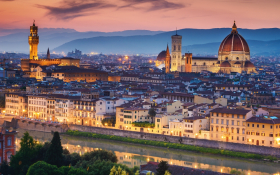
Florence is the capital city of the region of Tuscany and was briefly (1865 – 1871) the capital of the kingdom of Italy. The city lies on the Arno River and as centre of medieval European trade and finance, the city is sometimes considered the birthplace of the Italian Renaissance. Florence is famous for its wealth of fine art and architecture and was long ruled by the Medici family. Monumento and art sites not to be missed are: the Uffizii Gallery, the Academy Gallery, the Palazzo Vecchio, the Duomo, the Giotto belltower, the St. John’s Baptistery, Santa Maria Novella, Santa Croce. Just to mention few, but the list can longer because each part of Florence, each street contains an art treasure.
< Pisa and Lucca
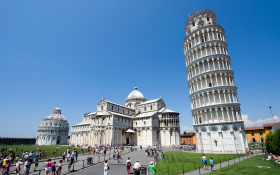
These two towns are located on the west part of Tuscany and while Pisa is worth a visit because of the famous Leaning Tower, Lucca is famous for its very well kept walls: nice way to visit this town is to rent a bike.
< Siena and San Gimignano
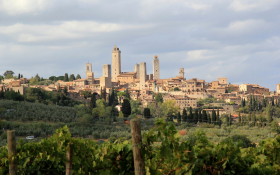
Located south of Florence, this two medieval towns are located in one of the Chianti areas. Siena is famous in the world for its beautiful square where every August the famous medieval horse race, called the Palio, is run, still respecting the rules of centuries ago. The nearby San Gimignano is famous for probably being the first town in the world having adopted the skyscrapers since the Middle Ages. In fact, at that time, more than 100 were the high towers that filled the sky of this wall-town. Some of these towers are still there.
< Chianti region
If you want to enjoy the real Chianti region with its hills filled with vineyards, just take a car and drive along the SS222, the famous Chianti road. You have not to be in a rush because you cannot drive that road fast: many are the views that can disturn your driving. You will pass by famous villages (Radda, Gaiole, Greve) and many castles (Verrazzano, Meleto, Vicchiomaggio, just to mention few): stop in one of those and ask to visit the wine cellars and to taste the wines they produce. Most part of these castles have also a restaurant, ideal place to stop for lunch and enjoy the quietness of the region.
< Tuscany - Overview
Tuscany was the region in which the Italian Renaissance produced its first results. The unique artistic patrimony of this region includes architecture, painting, and sculture, collected in dozens of famous museums. In the late Middle Ages and throughout the Renaissance, Tuscany was a center of the arts and of learning. The Tuscan spoken language became the literary language of Italy after Dante Alighieri, Petrarch, and Boccaccio used it. Notable schools of architecture, sculpture, and painting developed from the 11th century in many cities, particularly Florence, Pisa, Siena, and Arezzo.
Florence

Florence is the capital city of the region of Tuscany and was briefly (1865 – 1871) the capital of the kingdom of Italy. The city lies on the Arno River and as centre of medieval European trade and finance, the city is sometimes considered the birthplace of the Italian Renaissance. Florence is famous for its wealth of fine art and architecture and was long ruled by the Medici family. Monumento and art sites not to be missed are: the Uffizii Gallery, the Academy Gallery, the Palazzo Vecchio, the Duomo, the Giotto belltower, the St. John’s Baptistery, Santa Maria Novella, Santa Croce. Just to mention few, but the list can longer because each part of Florence, each street contains an art treasure.
Pisa and Lucca

These two towns are located on the west part of Tuscany and while Pisa is worth a visit because of the famous Leaning Tower, Lucca is famous for its very well kept walls: nice way to visit this town is to rent a bike.
Siena and San Gimignano

Located south of Florence, this two medieval towns are located in one of the Chianti areas. Siena is famous in the world for its beautiful square where every August the famous medieval horse race, called the Palio, is run, still respecting the rules of centuries ago. The nearby San Gimignano is famous for probably being the first town in the world having adopted the skyscrapers since the Middle Ages. In fact, at that time, more than 100 were the high towers that filled the sky of this wall-town. Some of these towers are still there.
Chianti region
If you want to enjoy the real Chianti region with its hills filled with vineyards, just take a car and drive along the SS222, the famous Chianti road. You have not to be in a rush because you cannot drive that road fast: many are the views that can disturn your driving. You will pass by famous villages (Radda, Gaiole, Greve) and many castles (Verrazzano, Meleto, Vicchiomaggio, just to mention few): stop in one of those and ask to visit the wine cellars and to taste the wines they produce. Most part of these castles have also a restaurant, ideal place to stop for lunch and enjoy the quietness of the region.
Tuscany - Overview
Tuscany was the region in which the Italian Renaissance produced its first results. The unique artistic patrimony of this region includes architecture, painting, and sculture, collected in dozens of famous museums. In the late Middle Ages and throughout the Renaissance, Tuscany was a center of the arts and of learning. The Tuscan spoken language became the literary language of Italy after Dante Alighieri, Petrarch, and Boccaccio used it. Notable schools of architecture, sculpture, and painting developed from the 11th century in many cities, particularly Florence, Pisa, Siena, and Arezzo.
< Florence

At just 90 minutes by train, you can go to Florence, a journey to discover the cradle of the Renaissance, where one's breaths art in the medieval streets, in the craftmen's workshops and in the Renaissance Palaces. Here the memories of the Medici family are united with the splendour of the works of illustrious artists as Michelangelo, Leonardo and Botticelli
Florence

At just 90 minutes by train, you can go to Florence, a journey to discover the cradle of the Renaissance, where one's breaths art in the medieval streets, in the craftmen's workshops and in the Renaissance Palaces. Here the memories of the Medici family are united with the splendour of the works of illustrious artists as Michelangelo, Leonardo and Botticelli
< Bellinzona and Lugano
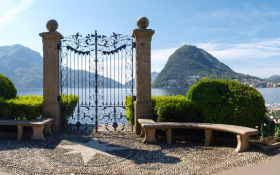
As Como is on the border with Switzerland, take the opportunity to visit Bellinzona, the town famous for its three castles. For lunch, we suggest a vineyard (surprise! This part of the Swiss territory, called Ticino, is very well known for the high quality of its Merlot wine!) before driving to Lugano and enjoy some shopping in the famous Via Nassa.
< Bellagio and the Villas and Gardens of Lake Como
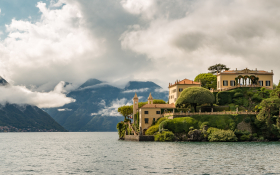
is a simply beautiful excursion around the lower part of Lake Como admiring enchanting villas and gardens: Villa Carlotta and Villa Balbianello, just to mention two of them. But, not only! While sailing towards Bellagio, you can have a look at the villas of Versace or of George Clooney and of some other VIPS who spend quite a lot of time on Lake Como. Once reached Bellagio, a beautiful hilly town in a picture-perfect location on the promontory where the lake separates into two branches, you have other two gardens to visti: Villa Melzi and Villa Serbelloni, the gardens of the Rockfeller Foundation. To end the day in a good day, have a nice cup of tea on the terrace of the Grand Hotel Villa Serbelloni.
< Como
Como is a lively and pleasant town with an appealing historical centre and a scenic location at the southern end of the east branch of Lake Como. The impressive cathedral, Duomo, was built and added to over a period of four centuries, so you can admire Gothic and Renaissance features including some fine tapestries and paintings. The town’s earlier cathedral (built in the tenth century), San Fedele, is another fine sight, as are the tall nine-hundred-year-old gateway, Porta Vittoria, and the Romanesque church Sant’Abbondio. For a short trip out of town, take the funicular up to the top of the hill above Como, where you can enjoy spectacular views. Como has been for centuries the world leader in the production of silk, and now, with China as a tough competitor, Como silk industry has specialized itself in high quality and design.
< Lake Como - Overview
Also called “the star with three points”, is made up of three branches, united in a charming central lake, but separated by different styles and cultures; The Colico branch is savage and pure, the Lecco branch is a natural jewel and the Como branch is refined and elegant. Lake Como occupies a very strategic position as it is not far-off are Lake Maggiore, the city of Milan, the capital of finance and fashion, and Lake Lugano in Switzerland.
< Milan
Being in Como, you cannot skip one day of visiting and shopping in the nearby Milan. The city can be reached by car or, more easily by train (just 30-minute journey). Once there, you have a wide choice of things to do: The Last Supper, the Duomo, the Castello, the Galleria and then the Shopping Triangle is yours: enjoy the truest fashion shopping in Italy.
Bellinzona and Lugano

As Como is on the border with Switzerland, take the opportunity to visit Bellinzona, the town famous for its three castles. For lunch, we suggest a vineyard (surprise! This part of the Swiss territory, called Ticino, is very well known for the high quality of its Merlot wine!) before driving to Lugano and enjoy some shopping in the famous Via Nassa.
Bellagio and the Villas and Gardens of Lake Como

is a simply beautiful excursion around the lower part of Lake Como admiring enchanting villas and gardens: Villa Carlotta and Villa Balbianello, just to mention two of them. But, not only! While sailing towards Bellagio, you can have a look at the villas of Versace or of George Clooney and of some other VIPS who spend quite a lot of time on Lake Como. Once reached Bellagio, a beautiful hilly town in a picture-perfect location on the promontory where the lake separates into two branches, you have other two gardens to visti: Villa Melzi and Villa Serbelloni, the gardens of the Rockfeller Foundation. To end the day in a good day, have a nice cup of tea on the terrace of the Grand Hotel Villa Serbelloni.
Como
Como is a lively and pleasant town with an appealing historical centre and a scenic location at the southern end of the east branch of Lake Como. The impressive cathedral, Duomo, was built and added to over a period of four centuries, so you can admire Gothic and Renaissance features including some fine tapestries and paintings. The town’s earlier cathedral (built in the tenth century), San Fedele, is another fine sight, as are the tall nine-hundred-year-old gateway, Porta Vittoria, and the Romanesque church Sant’Abbondio. For a short trip out of town, take the funicular up to the top of the hill above Como, where you can enjoy spectacular views. Como has been for centuries the world leader in the production of silk, and now, with China as a tough competitor, Como silk industry has specialized itself in high quality and design.
Lake Como - Overview
Also called “the star with three points”, is made up of three branches, united in a charming central lake, but separated by different styles and cultures; The Colico branch is savage and pure, the Lecco branch is a natural jewel and the Como branch is refined and elegant. Lake Como occupies a very strategic position as it is not far-off are Lake Maggiore, the city of Milan, the capital of finance and fashion, and Lake Lugano in Switzerland.
Milan
Being in Como, you cannot skip one day of visiting and shopping in the nearby Milan. The city can be reached by car or, more easily by train (just 30-minute journey). Once there, you have a wide choice of things to do: The Last Supper, the Duomo, the Castello, the Galleria and then the Shopping Triangle is yours: enjoy the truest fashion shopping in Italy.
< Franciacorta
Situated west of Brescia, between the main road to Milan and Lake Iseo, Franciacorta is the kingdom of wine, the sparkling land of bubbles. Here grapes give life to high-quality wines, among which is the Franciacorta D.O.C.G. whic has reached high levels of excellence and is appreciated the world over.
< Gardone Riviera
Apart being a tourist resort, Gardone Riviera is famous for the Hruska Gardens, beautiful and fully comprehensive botanical gardens and for “Il Vittoriale degli Italiani”, the villa of Gabriele D’Annunzio that, after his death, was declared a national monument and is visited every years by hundreds of thousands of tourists. With its eccentric object, kitsch relics, gift from famous figures of the time and surreal rooms, it is a place of fantasy and reminiscence.
< Lake Garda - Overview
Lake Garda, the largest lake in Italy, is located in Northern Italy about half-way between Venice and Milan in an alpine region and was formed by glaciers at the end of the last ice age. The lake and its shoreline are divided between the provinces of Verona (to the south-east), Brescia (south-west), and Trento (north). The lake is a major tourist destination with a number of hotels and resorts along its shore.
< Sirmione
The town of Sirmione, located on the south of the lake is one particularly popular destination, home to the Virgilio & Catullo Spa Complexes, as well as numerous restaurants, bars, hotels, fashion stores and a market. Sirmione's most striking feature is the castle, Rocca Scaligera. Sirmione's narrow medieval streets bustle with color and life. At the very tip of the peninsula green lizards scuttle over the extensive remains of a grand Roman villa; visitors can wander through the ruined walls and admire archeological finds - including a charming carving of rabbits - in the small museum.
< Verona and the Valpolicella wine area
So near to Lake Garda is Verona, the town made famous in the world by Shapespeare with his Romeo and Juliet tragedy and by the Opera Season, held each year in the Arena, the still very well preserved theatre dating back to the Roman times. Verona is also a beautiful historical centre with shops and squares where markets are held every day. Driving few kilometer north of the town, you will enter the wine region called Valpolicella: here many are vineyards that open their doors to the tourists to let them visit the wine cellars and taste some of their wines.
Franciacorta
Situated west of Brescia, between the main road to Milan and Lake Iseo, Franciacorta is the kingdom of wine, the sparkling land of bubbles. Here grapes give life to high-quality wines, among which is the Franciacorta D.O.C.G. whic has reached high levels of excellence and is appreciated the world over.
Gardone Riviera
Apart being a tourist resort, Gardone Riviera is famous for the Hruska Gardens, beautiful and fully comprehensive botanical gardens and for “Il Vittoriale degli Italiani”, the villa of Gabriele D’Annunzio that, after his death, was declared a national monument and is visited every years by hundreds of thousands of tourists. With its eccentric object, kitsch relics, gift from famous figures of the time and surreal rooms, it is a place of fantasy and reminiscence.
Lake Garda - Overview
Lake Garda, the largest lake in Italy, is located in Northern Italy about half-way between Venice and Milan in an alpine region and was formed by glaciers at the end of the last ice age. The lake and its shoreline are divided between the provinces of Verona (to the south-east), Brescia (south-west), and Trento (north). The lake is a major tourist destination with a number of hotels and resorts along its shore.
Sirmione
The town of Sirmione, located on the south of the lake is one particularly popular destination, home to the Virgilio & Catullo Spa Complexes, as well as numerous restaurants, bars, hotels, fashion stores and a market. Sirmione's most striking feature is the castle, Rocca Scaligera. Sirmione's narrow medieval streets bustle with color and life. At the very tip of the peninsula green lizards scuttle over the extensive remains of a grand Roman villa; visitors can wander through the ruined walls and admire archeological finds - including a charming carving of rabbits - in the small museum.
Verona and the Valpolicella wine area
So near to Lake Garda is Verona, the town made famous in the world by Shapespeare with his Romeo and Juliet tragedy and by the Opera Season, held each year in the Arena, the still very well preserved theatre dating back to the Roman times. Verona is also a beautiful historical centre with shops and squares where markets are held every day. Driving few kilometer north of the town, you will enter the wine region called Valpolicella: here many are vineyards that open their doors to the tourists to let them visit the wine cellars and taste some of their wines.
< Lake Maggiore - Overview
Famous for its colours and its scents, Lake Maggiore offers the visitor a scenario whose beauty can be enjoyed in a new and different way in every season; the famous islands of the Borromeo Gulf (Isola Bella, Isola dei Pescatori, Isola Madre, the islets of San Giovanni and Malghera), a tiny and picturesque archipelago, seem to be painted in one of the most beautiful landscapes in the world. Lake Maggiore is located 60 miles west of Milan and its northern part is part of the Swiss territory. Lake Maggiore is famous for its gardens: Isola Madre, Isola Bella, Villa Tarando and Villa Pallavicino.The entire coastline of the Lake is disseminated with many historical villas surrounded by centuries old parks, some of which may be visited if arrangements are made in advance.
< Mottarone Mountain
Mottarone's summit, at an altitude of 1491 metres, can be reached by car or cable car from Stresa. The 9 km panoramic road, "La Borromea", that leads up to this splendid natural spectacle offers the observer remarkable scenery along the way that includes green meadows, sparkling streams and luxuriant woods, not to mention unforgettable sweeping views over Lake Maggiore and, off into the distance, the Padana Plains and the peaks of the Italian and Swiss Alps.
< The Botanical Gardens of Isola Bella
This is an example of a typical Italian garden where nature has been modified to create a scenographic vision enriched with ornamental architecture and sculpture, reflecting pools and fountains and decorative flowerbeds laid out according to geometric designs, the various species planted in harmonious arrangements of colour. Narrow paths around the palazzo lead to the inner courtyards, like the Cortile di Diana or theTeatro di Ercole , adorned with a series of statues inserted into special niches, or the Giardino d'Amore which is especially famous for being the setting of romantic encounters between Napoleon and Josephine Bonaparte during their sojourn here in 1797. The gardens were further embellished with numerous botanical species, from jasmine to orange and pomegranate, not to mention, orchids, rhododendron, azaleas and camellias. Isola Bella then, not only for having been named after Isabella d'Adda, Carlo III Borromeo's wife, but also because of its magnificent gardens on the ten most famous terraces of the Borromeo Gulf.
< The Botanical Gardens of Isola Madre
Its name identifies this as the largest of the three islands in the Borromeo Gulf.Isola Madre is distinguished by gardens which have preserved their natural aspect, as well as by the presence of exotic birds which fly freely among the centuries-old trees. Its not unusual in fact to come across Chinese pheasant hens or white peacocks trailing their tails between the budding camellia or the hedges of flowering magnolia. As on Isola Bella, the gardens here have also been planted on terraces, and include such rarities as the spectacular cypress of Kashmir and a Jubaeae Spectabilis palm of the venerable old age of 125.
< The Islands
The three main islands may be reached by means of an efficient public navigation service or by means of the characteristic "taxi boats": the Isola Bella with its Borromeo Palace (XVII century), surprises those arriving from the lake on account of its majestic and almost unreal baroque setting. Its park, a masterpiece of Italian style garden, is laid out on ten terraces that degrade down to the lake, while, today, the palace houses a picture gallery that may be visited from March to October. The Isola dei Pescatori is a picturesque village, inhabited by a small community that still makes a living by fishing. A maze of alleys will lead the visitor to discover the typical restaurants and the traditional open air market. The Isola Madre is a botanical garden on water, abounging in rare plants, exotic flowers and free-roaming animals, thanks to the favorable micro climate, create on the island the enchantment of a tropical green house.
< Villa Taranto
Villa Taranto Botanical Gardens cover an area of about 20 hectares on the Castagnola Promontory in Pallanza. The history of the gardens goes back to 1931 when a Scottish gentleman and Royal Archer to the Queen, Captain Neil Boyd McEacharn, acquired from the Marchesa di Sant'Elia, the property known as "La Crocetta", with the intention of transforming it into one of the most important botanical complexes in the world. He re-baptised it "Villa Taranto" in honour of one of his ancestors who was named Duke of Taranto by Napoleon. The importance of the gardens is due not only to the botanical patrimony contained therein, a wealth of over 20,000 varieties and species, but also to the beauty and harmony of the complex. The English stamp on the park has been enriched by Latin taste and sensibility through the insertion of elements typical to Italian gardens.
Lake Maggiore - Overview
Famous for its colours and its scents, Lake Maggiore offers the visitor a scenario whose beauty can be enjoyed in a new and different way in every season; the famous islands of the Borromeo Gulf (Isola Bella, Isola dei Pescatori, Isola Madre, the islets of San Giovanni and Malghera), a tiny and picturesque archipelago, seem to be painted in one of the most beautiful landscapes in the world. Lake Maggiore is located 60 miles west of Milan and its northern part is part of the Swiss territory. Lake Maggiore is famous for its gardens: Isola Madre, Isola Bella, Villa Tarando and Villa Pallavicino.The entire coastline of the Lake is disseminated with many historical villas surrounded by centuries old parks, some of which may be visited if arrangements are made in advance.
Mottarone Mountain
Mottarone's summit, at an altitude of 1491 metres, can be reached by car or cable car from Stresa. The 9 km panoramic road, "La Borromea", that leads up to this splendid natural spectacle offers the observer remarkable scenery along the way that includes green meadows, sparkling streams and luxuriant woods, not to mention unforgettable sweeping views over Lake Maggiore and, off into the distance, the Padana Plains and the peaks of the Italian and Swiss Alps.
The Botanical Gardens of Isola Bella
This is an example of a typical Italian garden where nature has been modified to create a scenographic vision enriched with ornamental architecture and sculpture, reflecting pools and fountains and decorative flowerbeds laid out according to geometric designs, the various species planted in harmonious arrangements of colour. Narrow paths around the palazzo lead to the inner courtyards, like the Cortile di Diana or theTeatro di Ercole , adorned with a series of statues inserted into special niches, or the Giardino d'Amore which is especially famous for being the setting of romantic encounters between Napoleon and Josephine Bonaparte during their sojourn here in 1797. The gardens were further embellished with numerous botanical species, from jasmine to orange and pomegranate, not to mention, orchids, rhododendron, azaleas and camellias. Isola Bella then, not only for having been named after Isabella d'Adda, Carlo III Borromeo's wife, but also because of its magnificent gardens on the ten most famous terraces of the Borromeo Gulf.
The Botanical Gardens of Isola Madre
Its name identifies this as the largest of the three islands in the Borromeo Gulf.Isola Madre is distinguished by gardens which have preserved their natural aspect, as well as by the presence of exotic birds which fly freely among the centuries-old trees. Its not unusual in fact to come across Chinese pheasant hens or white peacocks trailing their tails between the budding camellia or the hedges of flowering magnolia. As on Isola Bella, the gardens here have also been planted on terraces, and include such rarities as the spectacular cypress of Kashmir and a Jubaeae Spectabilis palm of the venerable old age of 125.
The Islands
The three main islands may be reached by means of an efficient public navigation service or by means of the characteristic "taxi boats": the Isola Bella with its Borromeo Palace (XVII century), surprises those arriving from the lake on account of its majestic and almost unreal baroque setting. Its park, a masterpiece of Italian style garden, is laid out on ten terraces that degrade down to the lake, while, today, the palace houses a picture gallery that may be visited from March to October. The Isola dei Pescatori is a picturesque village, inhabited by a small community that still makes a living by fishing. A maze of alleys will lead the visitor to discover the typical restaurants and the traditional open air market. The Isola Madre is a botanical garden on water, abounging in rare plants, exotic flowers and free-roaming animals, thanks to the favorable micro climate, create on the island the enchantment of a tropical green house.
Villa Taranto
Villa Taranto Botanical Gardens cover an area of about 20 hectares on the Castagnola Promontory in Pallanza. The history of the gardens goes back to 1931 when a Scottish gentleman and Royal Archer to the Queen, Captain Neil Boyd McEacharn, acquired from the Marchesa di Sant'Elia, the property known as "La Crocetta", with the intention of transforming it into one of the most important botanical complexes in the world. He re-baptised it "Villa Taranto" in honour of one of his ancestors who was named Duke of Taranto by Napoleon. The importance of the gardens is due not only to the botanical patrimony contained therein, a wealth of over 20,000 varieties and species, but also to the beauty and harmony of the complex. The English stamp on the park has been enriched by Latin taste and sensibility through the insertion of elements typical to Italian gardens.










































